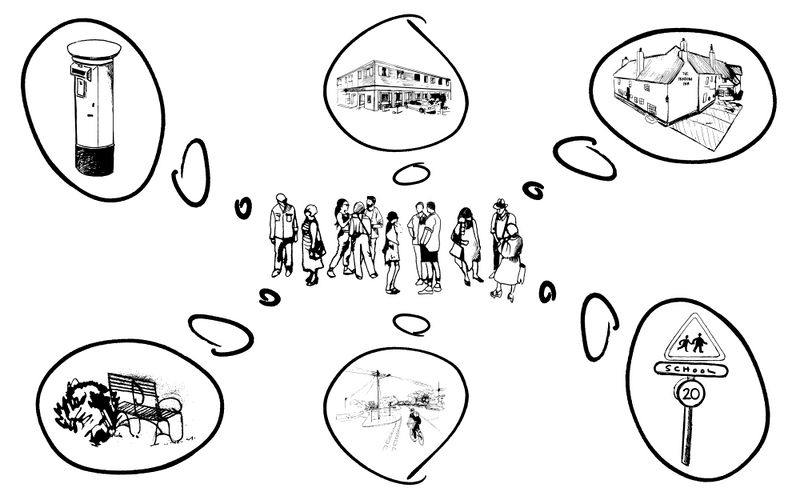LC 00811: verschil tussen versies
Geen bewerkingssamenvatting |
k (1 versie geïmporteerd) |
(geen verschil)
| |
Huidige versie van 23 mrt 2023 om 09:11
This page outlines key consderations for applying HAIRE's Neighbourhood Analysis tool. An expandable section on practical steps and tips follows.
Neighbourhood Analysis creates a brainstorm of resources that are available locally. The main aim is to show the assets that are available to a community, as told by the locals. Eight categories are used to organise responses. The categories and examples of resources that may be listed under them are summarised below:
People: Individuals in the community with knowledge, skills, experience, and expertise. It's important to consider all age groups and people who tend to be overlooked in formal settings.
Examples: People who organise recreational social activities, professional activities, knowledge and skills sharing opportunities and those who participate in volunteering, where formal and informal help is given to other locals.
Places: Physical elements of the community, such as community buildings and meeting rooms where activities take place and where people organise gatherings, meetings and socialise.
Examples: Community buildings, churches, park benches and popular hangouts.
Networks and informal links / connections: Networks in which people can communicate in a less formal manner. This category often connects with the physical places where people can meet to discuss local problems and challenges.
Examples: Neighbourhood and community groups, faith-based groups and village councils (organised and run by residents).
Partnerships: Collaborative forms of local partnerships - focus on the networks and partnerships connecting the community and its members. Connections that promote and support positive change are important.
Examples: Youth networks and regional development and economic forums.
Associations, groups, institutions (organisations), and services: Local associations, community groups, recreational groups, clubs, social housing associations, and other services run by key organisations.
Examples: Schools and other educational groups, sports and activity clubs, conservation groups, health centres and general practitioners.
Local entrepreneurs: Economic actors in the community, including local companies, and business leaders.
Examples: Supermarkets, local shops and tourism-related companies.
Culture: Important places, traditions and activities that are of meaning to the community.
Examples: Museums, music and arts movements, historical activities and festivals.
History and heritage: This category goes beyond chronological history and considers examples of local action. The collation of such activity helps to put local experiences and knowledge into context and documents past processes, plans and efforts for community development.
Examples: Community campaigns, community-led planning proposals, and other activities that give the local community a voice.
Training Tips
Preparing for a Session - what is needed?
· A separate space (e.g. room or outdoor area) for everyone to meet.
· Large space to write (e.g. white board, black board or large sheet of paper).
· Different coloured pens for the Neighbourhood Analysis’s eight different categories.
· A fixed time for a Neighbourhood Analysis session. A 2-hour session is usually long enough to develop a useful brainstorm.
Roles in a Neighbourhood Analysis Session
Facilitators
· Two facilitators are advised. One to invite participants to think about local resources under each Neighbourhood Analysis category and one to create the brainstorm.
Participants (6-8 local participants in each session)
· People must be familiar with the local area and community that the Neighbourhood Analysis aims to learn about.
· It is useful to invite contributions from locals with different backgrounds. In HAIRE’s pilot sites in the Netherlands, participant groups consisted of social workers, community workers, policy workers, business owners, individuals that run social activities and residents.
· Multiple sessions can run in a community to ensure that a good range of participants are invited. This is particularly important for communities that have distinct areas, e.g. in HAIRE’s Feock, UK, pilot site, three different areas within the pilot site were invited to generate their own Neighbourhood Analysis brainstorms. The results from these sessions were then collated into an overall directory of resources.
Summary of key steps and further considerations
1. Start with noting the name of the local area or community in the middle of a large writing space (whiteboard, blackboard or large-sized paper).
2. Use the categories of the Neighbourhood Analysis to generate a brainstorm of local resources.
3. Try to make connections between the listed resources by drawing lines between them. You can be messy!
4. At the end of the session recap and identify the resources that were noted down.
5. If you have time, organise another Neighbourhood Analysis with a different group of people discussing the same area and community. It is interesting to see similarities and differences in the Neighbourhood Analysis sessions held with different groups about the same area.
6. Additional Neighbourhood Analysis sessions can be conducted in the future to build on the resources that were listed during initial sessions. This can capture resource development in an area and/or help to capture resources that were unknown during a first session.
Covid-19 Adaptation
Neighbourhood Analysis can be adapted to address social distancing restrictions to meeting in person. In HAIRE, some partners used a grid that included the Neighbourhood Analysis tool’s eight categories. This was sent out to individuals via email with an explanation of each category and they were asked to list relevant local resources in the grid. Download the grid here: Neighbourhood Analysis During Covid-19


